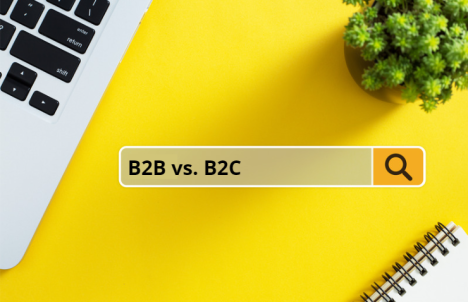Do you want to take your business’s digital marketing campaigns to the next level? Developing a B2B keyword strategy is essential for any campaign, and this guide is here to help.
A good keyword research strategy is critical to improving your search engine optimization (B2B SEO). As a result your business will have better content that supports effective lead generation by connecting customers with what they’re searching for.
For companies looking to optimize their B2B digital marketing campaigns with a keyword strategy, there are certain steps to consider when crafting an effective plan. Below are six of those steps that will help provide the best foundation for your business’s keyword strategy and give you the edge over competitors.
However, before we start, it’s essential to know what B2B keywords are and how it differs from B2C keywords.
. . .
Contents
. . .
What Are B2B Keywords?

B2B keywords are keywords that are specifically related to business-to-business (B2B). These keywords reflect the products, services, or solutions that businesses offer to other businesses.
B2B keywords are typically more industry focused and specific, while B2C keywords tend to be more broad and benefits focused. B2B keywords and are used in search queries by decision-makers looking to solve business problems or improve processes. Examples of B2B keywords can include industry-specific terms, product names, or technical solutions.
B2B vs. B2C Keywords

Although the terms B2B and B2C sound similar, B2B and B2C keywords differ in several ways, including the following:
- Intent: B2B keywords tend to have a more professional or technical focus and are used by decision-makers in a business setting. B2C keywords are more focused on consumer wants and needs and are often used by individuals for personal purposes.
- Language: B2B keywords tend to use more industry-specific language, technical terms, and acronyms. B2C keywords are often more conversational and consumer-friendly.
- Search Volume: B2B keywords often have a lower search volume than B2C keywords, but the searches tend to be more targeted and motivated by a specific need. B2C keywords tend to have a higher search volume but may be less focused and less motivated by a specific need.
- Buying Cycle: B2B purchasing decisions often involve a longer buying cycle, with multiple decision-makers involved, and a higher level of scrutiny. B2C purchasing decisions tend to be quicker, made by a single individual, and based on personal preferences and emotions.
Overall, B2B keywords tend to be more technical, industry-specific, and reflective of the specific needs of businesses, while B2C keywords are more consumer-focused, conversational, and reflect personal wants and needs.
Benefits Of Crafting A B2B Keyword Strategy

When it comes to crafting your B2B keyword strategy, there are several key benefits worth considering that will advance your digital marketing campaigns:
- Improved search engine optimization (SEO): By researching and targeting specific keywords, a B2B company can improve its visibility in search engine results pages (SERPs), thereby attracting more qualified, organic traffic to its website. According to Hubspot, companies that consistently blog generate 67% more leads per month than those that do not blog.
- Increased relevance: By targeting relevant keywords, a B2B company can ensure that its content is more relevant to its target audience, making it more likely that visitors will engage with it. The Content Marketing Institute notes that 81% of B2B buyers conduct research online before making a purchase decision, and 60% of B2B buyers say that the content on a vendor’s website heavily influences their purchasing decision.
- Better targeting: Keyword research provides insights into what potential customers are searching for, allowing a B2B company to better target its messaging and offerings to meet their needs.
- Increased conversions: By optimizing its website and content for relevant keywords, a B2B company can increase the chances of converting visitors into customers. According to DemandGen, 70% of B2B companies report increased website traffic and leads as a result of implementing a B2B keyword strategy.
- Competitive advantage: By developing a well-researched keyword strategy, a B2B company can gain a competitive advantage by differentiating itself from other businesses that may not be targeting the same keywords.
6 Steps To Crafting A Winning B2B Keyword Strategy
1. Understand Your Target Audience, Brand, & Goals

The first step in creating an effective keyword strategy is to identify your target audience (i.e. ideal customers). Knowing who you’re trying to reach will help you determine which keywords and phrases they are likely to use in their searches. (Consider the age, gender, interests, location, and other factors of your target audience when selecting keywords.)
Take the time to discover who your target audience with a B2B Buyer Persona. This help uncover pain points, and what type of content or solutions resonates with them. Marketing a B2B business requires knowing your target audience is a crucial step in determining who you are as a brand and which topics your company should focus on that aligns with your goals.
2. Brainstorm Topics & Initial Keywords

Once you’ve established an understanding of who your target audience is, it’s time to brainstorm relevant topics and phrases that are related to your target audience’s needs.
Start by jotting down the first 10-20 keywords that come to mind. Then ask someone that is not on your team to create a list of 10-20 keywords. The key is to look past the obvious keywords and come up with different angles on concepts that could bring more organic traffic or generate more leads for your business.
3. Keyword Research & Competitor Analysis

After you’ve created an initial keyword list, the next step is to research your keywords for volume and difficulty. You’ll want to research the content that your competitors are ranking for to identify any gaps in your strategy. By looking at what keywords other businesses in your space are targeting, you’ll be able to expand your list even further.
Research and competitive analysis can be done with tools such as Mangools, Ahrefs, SEMrush, or Google Keyword Planner. They will help you to generate a list of relevant keywords based on the target audience and competitor analysis. These tools can also search competitor backlinks and offer insights into which phrases competitors may be targeting in their SEO campaigns. (This kind of research can give you a leg up when creating a content strategy around the same topic.)
4. Prioritize Keywords: Analyze Search, Volume, & Usage

Next, evaluate the search volume, relevance, and competition level of each short-tail keyword, then prioritize those with the highest potential to drive traffic and conversions before diving deeper into aggregating long-tail keywords that encompass all of these themes. This will help you understand usage rates for all searches related to the broader topic and help guide decisions about how much effort should be put into particular queries depending on their volume/value metrics.
5. Assign Keywords To Current Content & Create A Plan For New Content

Once all keyword research has been completed, start assigning one or two keywords to all of your current web pages (including blogs). Start with the most important pages if your site is large. If you end up with keywords from your list that don’t fit into any of your current pages, then you’ll have an opportunity to create new pages or posts. Start by creating product or service pages before starting your b2b blog strategy.
Ensure the content meets quality standards while also incorporating the keyword successfully throughout your page, including:
- headings
- page titles
- meta descriptions
- page body
- alt text
Also, don’t forget to link internally between pages that contain related themes or topics, such as in blog content. Continuously monitor and adjust the strategy based on performance and changes in the market.
6. Track Your Keyword Performance

After you’ve integrated keywords into your website content, start tracking your SEO KPIs, including keyword performance. You can track performance with tools like Google Search Console and Google Analytics.
Creating a successful B2B keyword strategy requires research, planning, and tracking. By following the six steps outlined above, you can create a comprehensive keyword strategy that will help your business reach its desired audience and increase traffic potential to your website. With the right tools, data analysis, and content optimization, you can create a winning keyword strategy that will bring more leads and conversions to your business.
. . .
Conclusion
If you found this blog post enjoyable, please let us know your thoughts. What other elements should be considered when developing an effective keyword strategy? Are there additional benefits we might’ve missed? Feel free to check out the rest of our website for similar blog content, and don’t forget to reach out for a free consultation. We’d love to get you started on your Synthesis Insights journey today!




